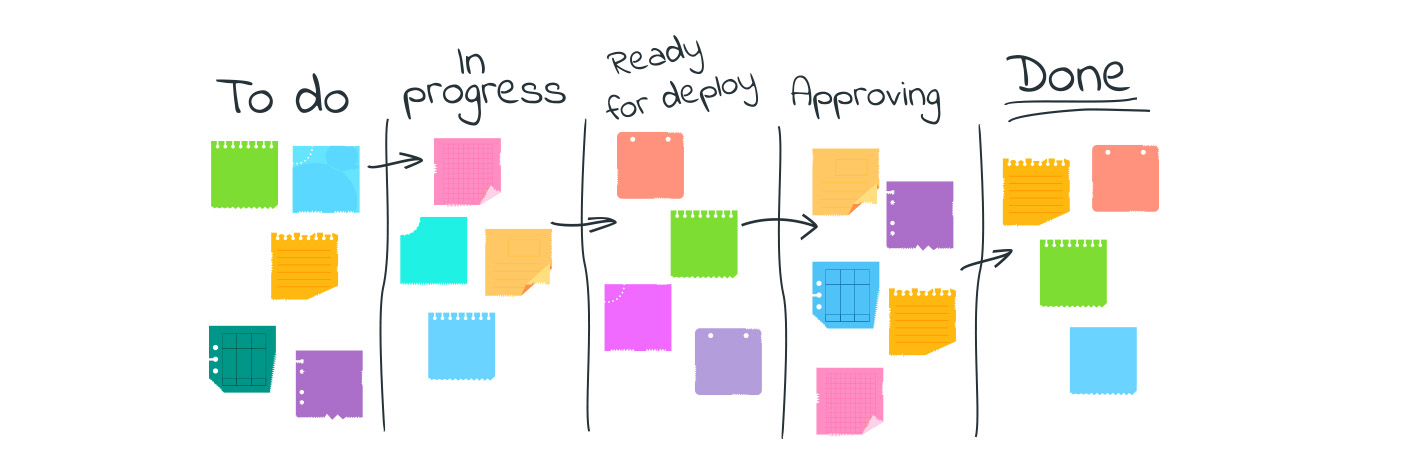The use of agile methodologies plays an essential role in ensuring efficiency and visibility in task execution. One of the most widely used methods for project management and tracking demands is Kanban, which aims to increase team productivity through a clear visualization of the progress of each task.
But how can you implement this method and ensure that you and your team achieve better results? Is there a specific area where applying this method can boost the success of a team? Let's find out in this article!
What is Kanban?
With a focus on task execution in a continuous workflow, Kanban is a management method that aims to increase the visibility of team tasks, in order to manage the progress of these activities in a simple and efficient way.
These are the general practices if you want to implement this method:
Visualize the workflow
Using a board with cards and columns is the first step. The boards can be physical or virtual, depending on the team and the company's segment. If you choose digital visualization, task management software like Qntrl can help you out on this mission.
The cards represent the tasks that each team or team member needs to perform. The columns represent the state each task is in throughout the execution process. These stages may vary depending on the industry, but generally, the most used ones are:
- Backlog
This is the space where tasks that still need to be executed are placed. Backlog items are not necessarily urgent, which means that this column can contain tasks that need to be done throughout all stages of the project, to ensure the complete execution of the project or initiative.
- To-Do
This column contains tasks of high priority that still need to be performed.
- In Progress
This is where tasks that are currently being executed are placed.
- Completed
After tasks are finished, they are moved to this column.
Make policies explicit
In the Kanban method, it is essential to have clearly established policies and communicate them to all the stakeholders involved in the process. With a defined and shared process, it becomes possible to identify areas to improve and increase the chances of success when doing a task and getting its results.
Limit work in progress
Another practice that is part of this method is limiting the number of tasks in progress. When there are too many tasks in the work-in-progress (WIP) column, the team will find it difficult to prioritize activities and achieve agile execution. It is practically impossible to stay focused when your attention needs to be divided among multiple tasks simultaneously, isn't it?
Manage the workflow, not the team
Kanban is about managing workflows instead of teams, which ensures that the work is executed in a smooth, agile, efficient, and healthy way. This is the moment when the visualization of work, along with the use of metrics, can be an important ally. The board provides a visual representation of the movement of work, while the numbers reflect the pace at which the activities are completed.
Implement feedback cycles
Another general aspect of the Kanban method is the implementation of feedback cycles, which can take the form of regular meetings. During these meetings, the team can establish their work cadence and define the tasks for each team member.
The feedback cycles don't aim to micromanage team members. The goal is to focus on the process and identify potential bottlenecks that may block the smooth execution of activities.
Collaborative improvement
By gathering feedback from the team and analyzing data to check how the workflow is performing, it is possible to implement improvements. The Kanban method aims to help the team evolve through the scientific method, which involves experimentation that may result in errors or successes. Regardless of the result, it will definitely lead to some growth for the workflow execution and stakeholders involved.
Benefits and use case examples
Kanban implementation can bring several advantages for you and your team:
- A holistic view of work processes
- Optimization of each step of the workflow
- Easier task prioritization
- Increased visibility of task status
- Improved focus when executing tasks
- Increased productivity and cost reduction
The Kanban method can be implemented in any industry or workflow and can be adapted to the specific needs of each area. In any segment, you can count on Qntrl to personalize your boards and create a customized visualization of the workflow.
Here are some examples of teams or processes that can benefit from this agile method:
- HR teams, for the hiring of new employees
- Sales teams, for inventory inclusion and monitoring
- Design, product, and engineering teams, for task execution
- Finance teams, for payroll control and processing
By implementing characteristics of the Kanban method, you can further refine the execution of tasks within your team, ensuring not only quality in delivery but also enabling continuous improvement in your company's work processes.
GUEST WRITER: Marina Meireles







